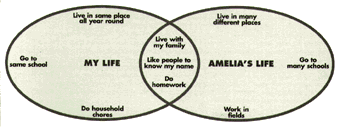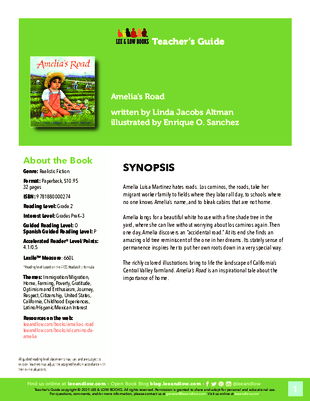TEACHER'S GUIDE FOR:
Amelia's Road
By Linda Jacobs Altman
Illustrations by Enrique O. Sanchez
Synopsis
Amelia Luisa Martinez hates roads. Los caminos, the roads, take her migrant worker family to fields where they labor all day, to schools where no one knows Amelia's name, and to bleak cabins that are not homes. She longs for the day when she doesn't need to move again, and can live in a tidy white house with a fine shade tree.
One day Amelia discovers an "accidental road." At its end she finds an amazing old tree. Its stately sense of permanence inspires her to put her own roots down in a special way–by placing her favorite things in a box and burying it next to the tree, so she will always have a place to go back to.
Background
There are between three million and five million migrant workers in America. They move from one harvest to another and do not have stable homes. Many of the migrant workers come from different parts of the world, such as Mexico, South America, or the Caribbean. But many of them are American citizens, born in the United States.
There are three "migrant streams" in the United States: The western stream begins at the Mexican border and works its way north to the Canadian border. Mexicans and Mexican Americans predominate in this stream. The central stream begins in south Texas, where crews of workers proceed north with the midwestern harvests; again, Mexicans and Mexican Americans predominate. The eastern stream works north from Florida into New England. Here, African Americans and Caribbean islanders predominate.
Some of the male workers travel by themselves and return to their families after the harvest. Others travel with their families. Out of necessity, even their children work in the fields.
Before Reading
Prereading Focus Questions
Before students read the story, you might want them to answer one of the following questions as a motivation for reading.
- Amelia's Road is about a young girl who lives in a family that travels around the country harvesting crops. The family rarely spends more than six weeks in one place. Would you like to live such a life? What would you dislike about moving from place to place all the time? Is there anything you would like about it?
- Amelia has a special place. Do you have a special place where you feel as though you belong? What is it like? Why is it special to you?
Vocabulary
- Before students read the story, have pairs of students search through the text for interesting or unfamiliar words. Have student volunteers write the words on the chalkboard. Discuss with students the possible meaning of each unfamiliar word.
- You might want to work with students to brainstorm a list of words that pertain to migrant farm workers. As you elicit students' prior knowledge, incorporate some of the vocabulary from the text, such as shanties, labor camps, harvest, and crops.
- Utilize the story as the basis for a lesson on compound words. Have students make a list of the compound words they encounter as they read (or reread) the text. After reading, they might compare their lists with those of other students. The story includes the following compound words: shortcut, cartwheels, highway, birthday, footpath, sunstruck, nowhere, someplace, nobody, everybody, anywhere, inside, and someday.
During Reading
Reader's Response Journals
To promote active reading, you might wish to have students keep a reader's response journal as they read the story. The journal will help students to personalize what they are reading. Tell students to write their reactions to the people and events in the story.
Have them keep these questions in mind as they read:
- Do you feel sorry for Amelia? Why or why not?
- Why do you think Amelia is happy that everyone in her class knows her name?
- How would you feel if you were Amelia?
- What part of the story did you like best? Why?
ELL/ESL Teaching Strategies
- You might wish to have students who speak English as a second language work together to dramatize the story. One student might play Amelia and others might be people in Amelia's life, such as her parents, her teacher, and her classmates. Suggest that students act out individual scenes from the story. The group might then perform the scenes for the class as a whole.
- Suggest to ESL students that they write down questions that occur to them as they read. Tell them to seek the answers as they read the story and write the answer next to each question.
After Reading
Writing Activities
Brainstorm writing ideas with a small group of students who have read the story. List their suggestions on a large sheet of paper. Encourage students to come up with ideas such as the following:
- Pretend that you are Amelia. You have gone with your family to a new harvest, and you are in a new school. Write a letter to Mrs. Ramos, telling her about the new school
- Write a poem about a place that is special to you.
- Imagine that you are Amelia's pen pal. Write a letter to her, telling what you like–or dislike–about your school.
Cooperative Learning
Divide the students who have read Amelia's Road into groups of four. Remind students that children like Amelia often do not spend more than a month or two at a new school before they move to the next harvest with their families. For this reason they are always the "new" student in a class.
Use the Roundtable structure to have students generate ideas for making such a student feel at home right away in the new classroom. In Roundtable, students in a group take turns adding information to the group's response to a prompt. Each student writes in turn, and the students work until all their ideas have been recorded.
Tell students to think of ways to let the new student know everyone's name (in addition to using name tags). Have students think of ideas for helping the new student learn the material that the class has already covered. Ask them to think of a parting gift for such a student that would help the child remember the school.
Hand each group of students a large sheet of paper with the column headings LEARNING NAMES, LEARNING SCHOOLWORK, and GOING-AWAY GIFT printed at the top. Tell students to pass the paper around the group, allowing each student to contribute his or her ideas in each column. To be sure that all students have contributed, you might want students to use pencils of different colors or to initial their work.
When the groups have had sufficient time to complete the exercise, ask them to share their charts with the other groups. You might wish them to combine the charts to create a class booklet on welcoming new students to the school.
Interdisciplinary Activities
In order to integrate students' reading experiences with other subject areas, you might want to have students complete one or more of these activities. Students can choose to write one of the following:
Social Studies
Amelia's Road is about migrant farm workers. Have students find out who Cesar Chavez was and why he became a hero to many migrant workers. Tell students to write a brief profile of Chavez. Ask for a volunteer to share the information with the class.
The diagrams should include information such as the following:

Mathematics
- Migrant farm workers pick fruits and vegetables from New York to Florida. Have students locate a map of the United States and, using the map legend, calculate how many miles a migrant worker family travels in a typical year as they move up and down the coast.
- Fruit is generally packaged and sold according to its dry weight. Have students use the following table of dry measures to make up word problems for the class.
2 pints =1 quart 8 quarts =1 peck 4 pecks =1 bushel
(Examples: There are five people in Amelia's family. How many pecks of apples would each member have to pick in order to have five bushels? If Amelia picks 2 pints of strawberries every hour, how many hours will she have to work to pick 3 quarts?)
Science
Fruits and vegetables are a very important part of everyone's diet. Have students draw and illustrate a food pyramid showing the proportion of fruits and vegetables in the ideal diet.
(Examples: There are five people in Amelia's family. How many pecks of apples would each member have to pick in order to have five bushels? If Amelia picks 2 pints of strawberries every hour, how many hours will she have to work to pick 3 quarts?)
Art
- Have students draw a map showing the places in the story. Ask them to illustrate the map and label the places shown. The maps should include: the labor camp (with Amelia's cabin indicated), the apple orchard, school, the accidental road, and the tree.
- Ask students to think of the special things they own that they would put in a box like Amelia's. Ask them to draw a picture of their special things and the box they would put them in.
About the Author and Illustrators
Linda Jacobs Altman is a writer based in Clearlake, California. Amelia's Road marked her picture book debut. This title carries special meaning for her: “I first became aware of the problems of migrant farm workers when Cesar Chavez was organizing the United Farm Workers in the 1960s. I identified especially with the migrant children because, like them, I grew up in a family where moving around was simply the way of things." She was born in Winston-Salem, North Carolina, and has lived in many parts of California. Her second book for Lee & Low, The Legend Of Freedom Hill is a fictional story set during the California Gold Rush, in which a girl teams up with her best friend, in search of gold to buy her mother’s freedom from a slave catcher.
Enrique O. Sanchez divides his home between Bar Harbor, Maine and Florida. He was born in the Dominican Republic and studied architecture at the Santa Domingo University and fine arts at the Bellas Artes Institute. He then moved to New York to study set and scene design and worked as a graphic designer for Sesame Street. While he is primarily a fine artist, he has illustrated many picture books (see below for full list).


About This Title
Guided Reading:
OLexile:
660LInterest Level:
Grades K - 3Reading Level:
Grades 2 - 3Themes
Latino/Hispanic/Mexican Interest, Immigration, Home, Farming, Poverty, Gratitude, Optimism/Enthusiasm, People In Motion, Respect/Citizenship, California, Realistic Fiction
Collections
English Fiction Grades 3-6, Fluent Dual Language , Fluent English, Appendix B Diverse Collection Grades 3-6, Realistic Fiction Grades 3-5, Bilingual English/Spanish and Dual Language Books , Mexico Culture Collection, English Fiction Grades PreK-2, California Book Collection , Social and Emotional Learning Collection, Latin American English Collection Grades 3-6, Dual Language Collection English and Spanish, Dual Language Levels N-Z Collection, Latin American Collection English 6PK, Immigration Collection, English Guided Reading Level O, Trauma-Informed Collection
Want to know more about us or have specific questions regarding our Teacher's Guides?
Please write us!general@leeandlow.com Terms of Use














